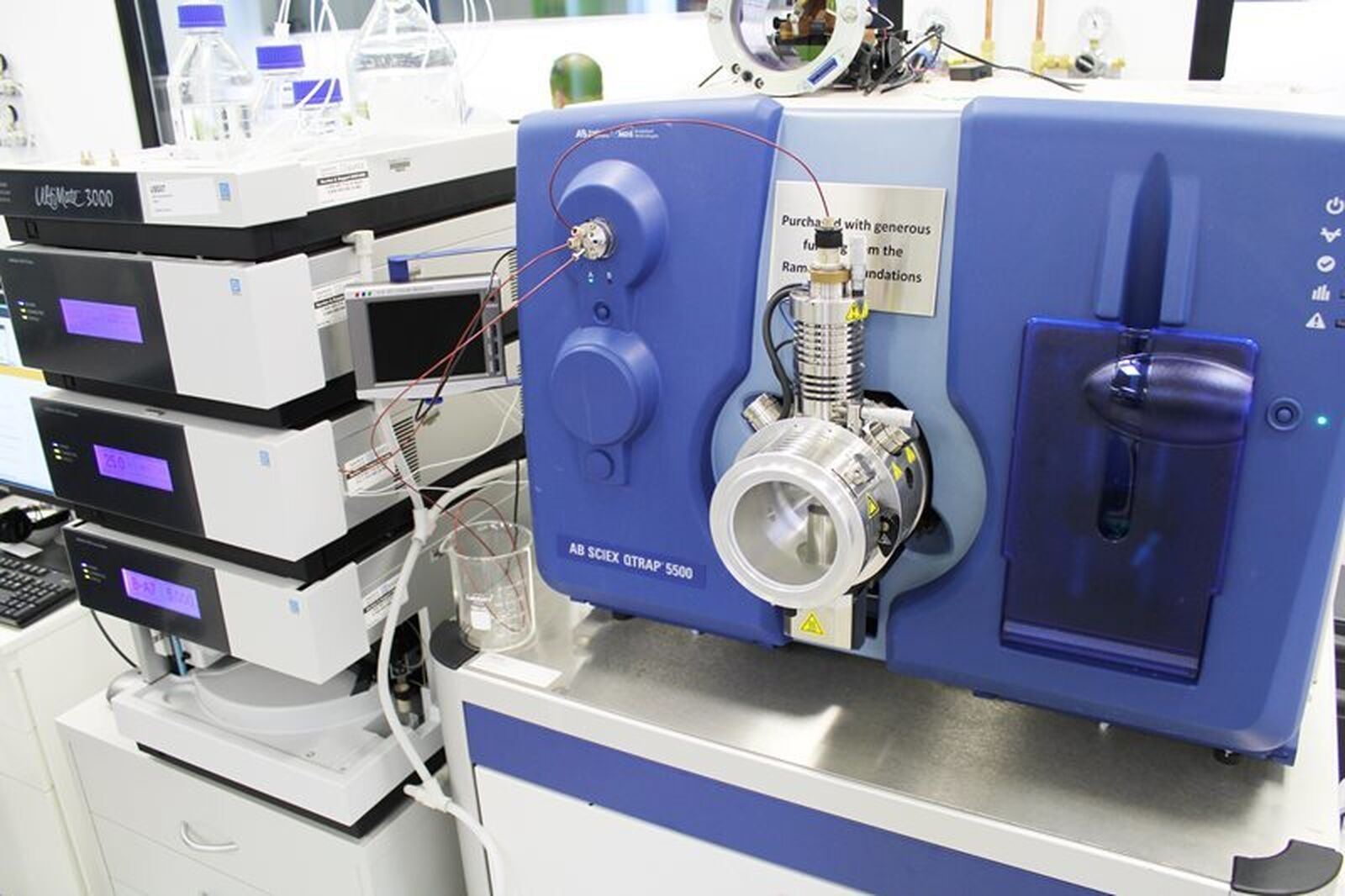
Biomedical Proteomics
Mass Spectrometry (MS) is an extremely powerful analytical technique that supports modern day biomolecular science, making MS a valuable tool in understanding the causes of disease.
Cellular life is made up of millions of unique molecules. MS measures the mass of molecules, facilitating the identification and characterisation of key components in biological processes (proteins, carbohydrates, DNA, metabolites). MS can also define the signalling events that drive biological processes by identifying post-translational modifications (e.g. protein phosphorylation).
Proteomics is the ability to study thousands of proteins in our cells and tissues simultaneously or to target important proteins to monitor one at a time. Biomedical Proteomics at Children's Medical Research Institute uses Liquid Chromatography–Tandem Mass Spectrometry (LC–MS/MS) equipment to perform proteomics.
The facility supports CMRI and the Westmead Research Hub, as well as collaborations with external groups and individuals. The facility offers access to equipment and advice on feasibility, methodology and data analysis.

Techniques/Technologies/Services
Untargeted proteomics and phosphoproteomics are the two main services performed at the facility using highly developed workflows that offer high depth of analysis. We also perform targeted protein analyses, custom protein analyses and custom metabolite analyses. Please contact us to discuss your project.
LC-MS/MS systems at the Biomedical Proteomics Facility:
The facility has an Astral Orbitrap and a Q Exactive Plus quadrupole-orbitrap mass spectrometry systems. The Astral Orbitrap is state-of-the-art, offering very rapid and very sensitive analysis of biomolecules. The Astral is allowing the analysis of difficult and precious patient samples that were previously too challenging. The Q Exactive Plus is a valuable work horse system that supports high throughput analysis for less cutting-edge applications.
Multiple equipment items to support LC-MS/MS:
A Vanquish Neo UHPLC system supports multiple off-line chromatography workflows with ultraviolet peptide detection and fraction collection to allow greater depth of proteome and phosphoproteome analysis.
A Laser Puller Sutter Instrument P-2000 and Nanobaume capillary column packer allow the production of nano-flow chromatography columns with a pulled tip. This column configuration allows zero dead volume between the chromatography material and the electrospray emitter, which enables very high-resolution chromatography and sensitive LC-MS/MS detection.
Independent use or full service:
The facility offers training so that researchers can become independent users of the MS equipment and use the adjoining wet laboratory space. The facility also offers full-service analysis of samples from lysis to LC-MS/MS and data processing. We partner with bioinformaticians to ensure quality outcomes.
If you have mass spectrometry application for your research, please discuss your needs with facility staff.
Dr Mark Graham, Lead Scientist

Dr Graham has over 20 years of experience in proteomics and specialises in phosphoproteomics.
Contact email: [email protected]
Facility Located at: Children's Medical Research Institute, 214 Hawkesbury Road, Westmead, NSW
Selected Recent Biomedical Proteomics Facility Publications
Epigenetic, ribosomal, and immune dysregulation in paediatric acute-onset neuropsychiatric syndrome. Velda X. Han, Sarah Alshammery, Brooke A. Keating, Brian S. Gloss, Markus J. Hofer, Mark E. Graham, Nader Aryamanesh, Lee L. Marshall, Songyi Yuan, Emma Maple-Brown, Jingya Yan, Sushil Bandodkar, Kavitha Kothur, Hiroya Nishida, Hannah Jones, Erica Tsang, Xianzhong Lau, Ruwani Dissanayake, Iain Perkes, Shekeeb S. Mohammad, Fabienne Brilot, Wendy Gold, Shrujna Patel and Russell C. Dale. Molecular Psychiatry. 30, 5389–5404 (2025).A Presynaptic Phosphosignaling Hub for Lasting Homeostatic Plasticity. Müller, J. A., J. Betzin, J. Santos-Tejedor, A. Mayer, A. M. Oprişoreanu, K. Engholm-Keller, I. Paulußen, P. Gulakova, T. D. McGovern, L. J. Gschossman, E. Schönhense, J. R. Wark, A. Lamprecht, A. J. Becker, A. J. Waardenberg, M. E. Graham, D. Dietrich, and S. Schoch. Cell Rep 39, no. 3 (Apr 19 2022): 110696.
Differentiation of Brain and Retinal Organoids from Confluent Cultures of Pluripotent Stem Cells Connected by Nerve-Like Axonal Projections of Optic Origin. Fernando, M., S. Lee, J. R. Wark, D. Xiao, B. Y. Lim, M. O'Hara-Wright, H. J. Kim, G. C. Smith, T. Wong, E. T. Teber, R. R. Ali, P. Yang, M. E. Graham, and A. Gonzalez-Cordero. Stem Cell Reports (Apr 19 2022).
Fludarabine Nucleoside Induces Major Changes in the P53 Interactome in Human B-Lymphoid Cancer Cell Lines. Almazi, J. G., M. Alomari, L. Belov, O. G. Best, Y. Shen, M. E. Graham, S. P. Mulligan, and R. I. Christopherson. Nucleosides Nucleotides Nucleic Acids (Dec 10 2021): 1-7.
Twist1 and Chromatin Regulatory Proteins Interact to Guide Neural Crest Cell Differentiation. Fan, X., V. P. Masamsetti, J. Q. Sun, K. Engholm-Keller, P. Osteil, J. Studdert, M. E. Graham, N. Fossat, and P. P. Tam. Elife 10 (Feb 8 2021).
Twist1 Homodimers and Heterodimers Orchestrate Lineage-Specific Differentiation. Fan, X., A. J. Waardenberg, M. Demuth, P. Osteil, J. Sun, D. A. F. Loebel, M. Graham, P. P. L. Tam, and N. Fossat. Mol Cell Biol (Mar 16 2020).
The Temporal Profile of Activity-Dependent Presynaptic Phospho-Signalling Reveals Long-Lasting Patterns of Poststimulus Regulation. Engholm-Keller, K., A. J. Waardenberg, J. A. Muller, J. R. Wark, R. N. Fernando, J. W. Arthur, P. J. Robinson, D. Dietrich, S. Schoch, and M. E. Graham. "" PLoS Biol 17, no. 3 (Mar 2019): e3000170.
Affinity Proteomics for Interactome and Phosphoproteome Screening in Synaptosomes. Engholm-Keller, Kasper, Nicolai Bache, Sushma R. Rao, Jesse R. Wark, Martin R. Larsen, Phillip J. Robinson, and Mark E. Graham. In Synaptosomes. Edited by Kathryn M. Murphy. New York, NY: Springer New York, 2018.
Identification of Atm Protein Kinase Phosphorylation Sites by Mass Spectrometry. Graham, M. E., M. F. Lavin, and S. V. Kozlov. Methods Mol Biol 1599 (2017): 127-44.

















